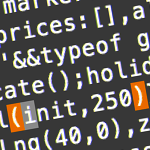Coupling is about how objects in your application are connected: which objects depend on which, and how does that affect the entire system’s stability?
An application has tight coupling when a lot of components depend on each other. This should usually be avoided because a change in 1 place can cause issues in any of its dependencies.
So what does coupling tell you about your classes?
Afferent coupling
Afferent coupling denotes the amount of incoming dependencies, i.e. how many other classes use this class.
Ideally, classes with high afferent coupling are small and have few responsibilities. Because so many others depend on such classes, they’re very hard to change without breaking something somewhere. These classes should be stable & thoroughly tested.
High afferent coupling is not necessarily a bad thing and will naturally occur for certain pieces of code (e.g. core functionality will usually score high). It only becomes a problem if those classes change often, or if afferent coupling is unnaturally high across the entire application.
The more classes depend on a class, the higher the chance one of them breaks when it changes.
Efferent coupling
Efferent coupling is about how many classes this class depends on, the amount of outgoing dependencies.
In a sense, it’s good to use other classes instead of duplicating that code, but it makes a class much harder to maintain. With lots of dependencies (e.g. parent classes/interfaces or parameter/variable types), a class becomes:
- Harder to read & maintain (because you have to know about those other classes)
- Harder to reuse (because it needs all those other components)
- Harder to test in isolation (because you have to setup those other modules)
- Brittle (because changes in those dependencies may cause errors)
High efferent coupling is an excellent indicator that a class is probably doing more than it should. Ideally, a class only has a single responsibility. An unfocused class like that can usually be decomposed into multiple smaller classes with a single responsibility.
The more dependencies a class has, the more likely it is to break when any of those change.
Instability
The ratio between efferent & total coupling (efferent + afferent) defines the (in)stability of a class. It shows how resilient a class is to change, how hard it is to change a component without impacting others in the application.
Classes with high efferent coupling (with lots of dependencies) but low afferent coupling (used by few others) are less stable: they’re likely to be impacted by changes in their dependencies, and they don’t have much depending on them so change is easy.
Stability or instability is about technical difficulty to change things, which may be at odds with the need or desire to change it. High stability is good, as long as you don’t need to change the implementation often.
A class should either be as stable as possible, or as unstable as possible. Those can always be refactored later, and having the instability in a few places is better than spreading it out across the entire system.
A class should depend only on classes that are more stable that itself.
If you want to look into coupling in your projects, head on to Cauditor, a code metrics visualization project I’ve been working on. Or run the PDepend suite if you’re only interested in the raw metrics.







